Fifty Years of Programming
and Moore's Law
by John Walker
November 4th, 2017
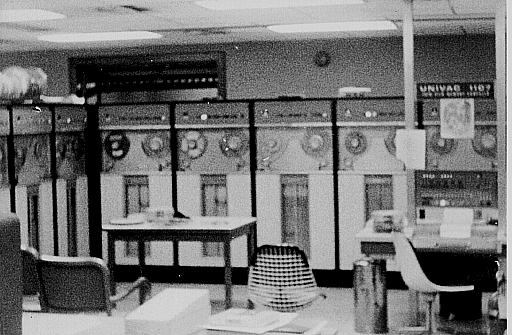 As best as I can determine, it was around fifty years
ago, within a week or so, that I wrote my first computer program,
directing my life's trajectory onto the slippery slope which
ended in my present ignominy. This provides an opportunity for
reflection on how computing has changed in the past half century, which
is arguably a technological transition unprecedented in the human
experience. But more about that later. First, let me say a few words
about the computer on which I ran that program, the Univac 1107 at Case
Institute of Technology, in the fall of 1967.
As best as I can determine, it was around fifty years
ago, within a week or so, that I wrote my first computer program,
directing my life's trajectory onto the slippery slope which
ended in my present ignominy. This provides an opportunity for
reflection on how computing has changed in the past half century, which
is arguably a technological transition unprecedented in the human
experience. But more about that later. First, let me say a few words
about the computer on which I ran that program, the Univac 1107 at Case
Institute of Technology, in the fall of 1967.
It Was Fifty Years Ago Today…
In the 1960s, the Univac® 1107 provided the main
computing facility for Case Institute of Technology in Cleveland Ohio
in the United States. Operated by the Andrew R. Jennings Computing
Center, the “Seven” enticed a generation into the world of
computing and, with the innovative “fast turnaround batch,”
“open shop” access pioneered at Case, provided a standard
of service to a large community of users almost unheard of at the time.
The Case 1107 was immortalised by being included by Case alumnus Donald
Knuth in the calculation of the decimal representation of the
MIX
1009 computer in
The Art of Computer Programming.
In the view above, we see the system console at the right, in front
of the bank of UNISERVO™ II-A tape drives. The rounded cabinet at the
very left of the frame is part of the TRW 530 “Logram
computer”, which was used primarily to convert tapes between
UNISERVO II-A 200 BPI format and the 800 BPI IBM-compatible format used
by the UNISERVO VIII-C drives on the 1108 at Chi Corporation.
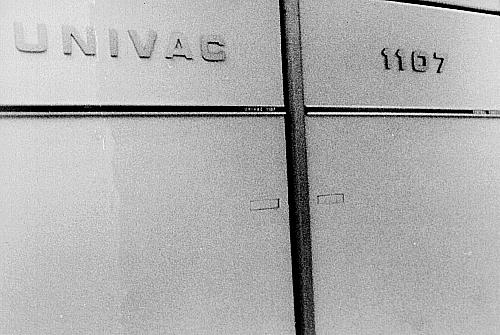
The Univac 1107 was massive, but quiet. All its main cabinets went
from floor to ceiling, with air conditioned air injected under the
raised floor and exit air exhausted over the dropped ceiling. Most of
the central computer cabinets were walk-in. This one contained the main
processor logic and the 65,536 36-bit words (about 256 K bytes) of core
memory. Memory access time was 8 microseconds per word, but
interleaving of instruction and data accesses allowed average access
time to approach 4 microseconds in ideal conditions.
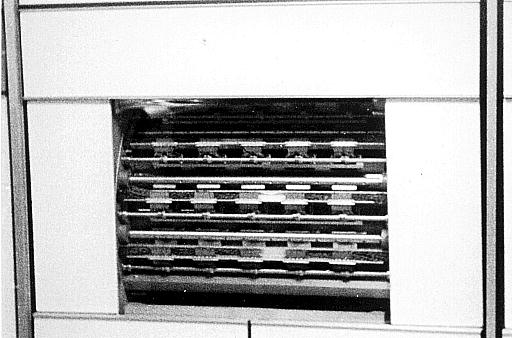
Mass storage for the single job run at a time, and for queueing
waiting jobs and printer output for those already complete, was
provided by the two FH-880 magnetic drums, one of which is shown
above, which together provided about 6 megabytes of random
access storage.
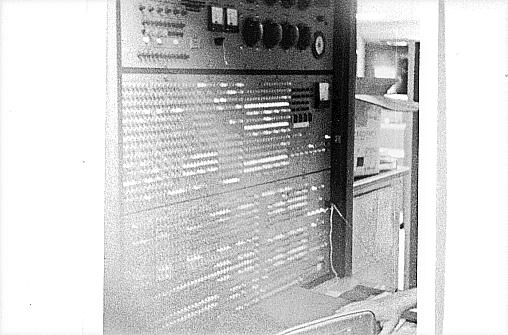
The central processor was a 36 bit architecture, capable
of executing most simple arithmetic instructions in one 4 microsecond
cycle time. Multiplication of two 36-bit integers took 12 microseconds,
and division of a 72-bit dividend by a 36-bit divisor 31.3
microseconds. The processor performed 36-bit single precision floating
point arithmetic in hardware, but did not implement double precision
floating point.
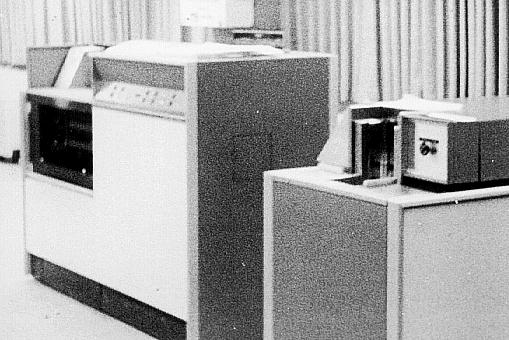
The high speed printer and card reader were connected directly to
1107 I/O channels. The printer was a rotating drum and hammer device
which printed 600 lines per minute. The card reader read 600 cards per
minute with two sets of brushes to read and verify the card; if they
did not agree, reading would halt. Cards were grasped by a
vacuum-equipped feed arm and fed into the mechanism.
The “card eater” was notorious for jamming, sometimes
demolishing student card decks which had been fed through numerous
times in the process of debugging a program. Note the prominent
Emergency Stop button to the right of the throat which ingested
the card deck. Fortunately, students in the “open shop”
environment in which the 1107 operated quickly learned how to
field-strip the card reader and remove the remains of their programming
projects when this happened.
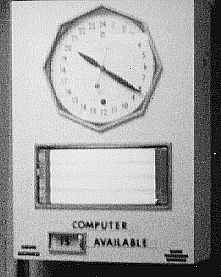 The high speed printer
was derived directly from a printer used on the Univac I. Its hammers
were driven by a bank of
thyratron
(gas-filled power switching) tubes which were visible when the back of
the printer was removed. When the drum advanced so the desired
character was approaching the hammer, the tube would fire and whack the
paper against the drum from the hammer bank behind the page. The
printer incorporated a feature known as the “all out
detector” which, if one or more hammers failed to fire on a given
line, leaving their corresponding drive tubes not “out”
(you could see the gas in them glowing until they fired), halted the
printer, permitting the operator to examine the printer controller,
note the missing characters, open the printer carriage, write them into
the columns they belonged with a pencil or pen, then restart the
printer. The pace of life was so much slower then….
The high speed printer
was derived directly from a printer used on the Univac I. Its hammers
were driven by a bank of
thyratron
(gas-filled power switching) tubes which were visible when the back of
the printer was removed. When the drum advanced so the desired
character was approaching the hammer, the tube would fire and whack the
paper against the drum from the hammer bank behind the page. The
printer incorporated a feature known as the “all out
detector” which, if one or more hammers failed to fire on a given
line, leaving their corresponding drive tubes not “out”
(you could see the gas in them glowing until they fired), halted the
printer, permitting the operator to examine the printer controller,
note the missing characters, open the printer carriage, write them into
the columns they belonged with a pencil or pen, then restart the
printer. The pace of life was so much slower then….
Also memorable about the high speed printer was that, due to its
both consuming and storing relatively large amounts of energy, along
with a supply of paper, its front panel was equipped with a Fire
indicator light and, directly below, an Extinguish button. I was
a very different person in those distant days of yore, and never pushed
Extinguish to see what, if anything, it did. However, one Friday
night while the system programmers and system programmer wannabes
(myself falling into the latter category) were watching Star
Trek in the hardware engineers' room (first airing of
The Original Series, you understand!) the Extinguish button
lighted up spontaneously without any obvious effect; a few switch flips
turned it off.

All jobs (“runs”) were initiated by reading in decks of
punch
cards from a card reader. Above is the main keypunch room where
most users prepared their programs. This room was open to anybody, 24
hours per day, and was equipped with IBM model 026 manual card punches.
The individual at the keypunch is unidentified. Visible through the
window at the end of the keypunch room is the computer room, with the
Univac 1004 card reader/punch and printer unit in the foreground.
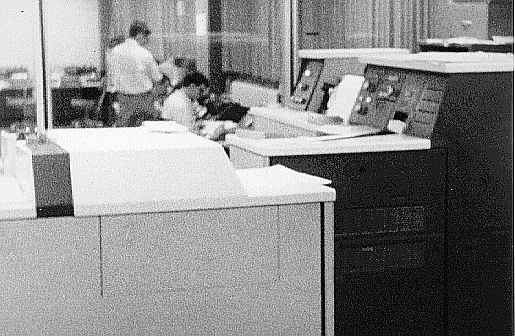
Here's a view of the 1004, with the keypunch room in the background.
This machine read 300 cards per minute and printed 300 lines per
minute. Though slower than the high speed reader and printer, it was
more reliable and its output generally more legible, so many preferred
it. Its card punch (at the left) was an awesome machine that punched an
entire 80 column IBM card all at once. A huge electric motor
powered the beast, and the GRRRrumble and then
whump, whump, whump when it came to life brings back
memories even today. The reader/printer unit is to the right. Punch
cards were introduced into a hopper to the right of the printer and
followed a tortuous path before emerging vertically in the bin visible
at the right of the unit. This bin was slanted upward slightly and a
weight with wheels on the bottom held the cards in place as the deck
filled the exit bin. If you happened to feed a deck into the 1004 when
this weight wasn't in place, the cards would spray out of the reader
through the air every which way, completely scrambling the contents.
This was extremely amusing to watch, as long as the cards weren't
yours.
The 1004 jammed less frequently than the high speed reader, but when
it did jam it could do so heroically. The high speed reader never
destroyed more than a single card at a time, but the 1004 could jam in
ways not detected by the machinery, which continued to feed more and
more cards to their certain doom, until their torn remains sufficiently
clogged the works to bring things to a halt. As I recall, the record
for the number of crumpled and shredded cards removed from a single
1004 jam was 17, but I believe that was a 1004-II which ran twice as
fast and was even more prone to jamming. Still, it was not unusual to
lose four or five cards in a 1004 jam.
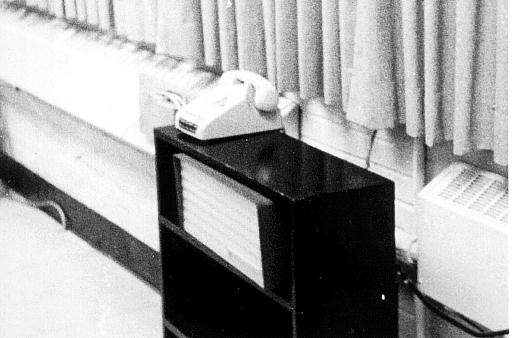
The Case 1107 was one of the first computers on Earth to provide
access from remote locations both at other places on the campus and as
far afield as Erie, Pennsylvania. This is the 2400 baud leased line
modem used for one of those connections. Now, if you have a modem, you
need a port to hook it up to. Here's a pair of 2400 baud serial ports,
1960s style.
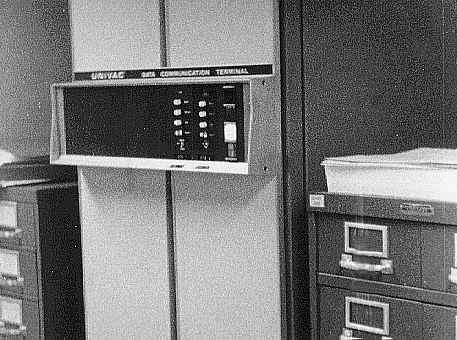
This floor-to-ceiling box (the file drawers for punch cards on either
side provide a sense of scale) was called the CTS—short for
“Communication Terminal, Synchronous”. It could contain
either one or two synchronous serial ports, each on a dedicated I/O
channel. This CTS has two ports; the vertical rows of round lights show
input and output activity on each port. Not only did the CTS consume an
entire I/O channel for each port (the 1107 only had 16
channels—you could put 16 tape drives on a channel
or…one serial port), it was a prodigious memory hog.
Input and output were stored with a single six bit character in each 36
bit word. If you transmitted and received small blocks of 1024
characters, and ran half-duplex so you didn't need separate input and
output buffers, the data buffer for a single remote terminal would
still consume 1/64th of the entire 65536 word memory of the 1107.

Day and night, the 1107 attracted individuals fired by the sense of
wonder of what such a machine and its descendents, properly programmed,
might do during their lifetimes. In this picture, from left to right,
are John Richards, Ken Walter, John Langner, and Gene Hughes. John
Walker snapped this candid picture.

The 1107 was installed on the first floor of the Quail Building,
shown above in a photo taken around 1966 by Bill Patterson. This is the
same building which previously housed Case's Univac I and Burroughs 220
computers. The keypunch room was on the near end of the left face of
the building in this view, and the 1107 occupied the far half of the
ground floor.
A Sense of Scale
The Univac 1107 I used in 1967 (which was, at the time, reaching the
end of its service life, and would be replaced the next year by its
successor, the Univac 1108) had a fundamental instruction clock rate of
250 kHz: it could execute simple instructions such as add, subtract,
and jump in around 4 microseconds, or 250,000 such instructions per
second. By the standards of 1967, this was pretty impressive: heck,
it's a lot faster than I can do such things, and it was
sufficient to meet the need for research and instructional computing
for a university with around 3,000 students. Let's look back at it from
the perspective of today's computers.
 I am writing this on a modest laptop whose processor runs at 3 GHz:
three billion instructions per second. Simply based upon the
clock rate, my current machine, fifty years after I ran my first
program, is twelve thousand times faster than the first computer I
used. But that isn't the whole story. The Univac 1107 had a single
processor, made of discrete transistors on circuit boards in a cabinet
the size of a kitchen. My laptop has eight processors, able to
all run in parallel, and if I manage to keep them all busy at the same
time, I have 96,000 times the computing power at my fingertips.
Further, the instructions are more powerful: the 1107 was limited to 36
bit integer and floating point computations: more precision required
costly software multiple precision, while my laptop has direct hardware
support for 64 bit quantities. This is probably worth another factor of
between two and four for applications such as graphics, multimedia, and
scientific computation.
I am writing this on a modest laptop whose processor runs at 3 GHz:
three billion instructions per second. Simply based upon the
clock rate, my current machine, fifty years after I ran my first
program, is twelve thousand times faster than the first computer I
used. But that isn't the whole story. The Univac 1107 had a single
processor, made of discrete transistors on circuit boards in a cabinet
the size of a kitchen. My laptop has eight processors, able to
all run in parallel, and if I manage to keep them all busy at the same
time, I have 96,000 times the computing power at my fingertips.
Further, the instructions are more powerful: the 1107 was limited to 36
bit integer and floating point computations: more precision required
costly software multiple precision, while my laptop has direct hardware
support for 64 bit quantities. This is probably worth another factor of
between two and four for applications such as graphics, multimedia, and
scientific computation.
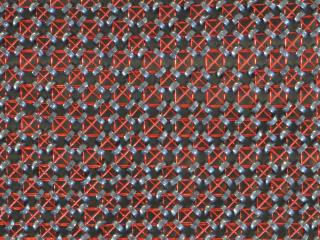 What about memory (or, as I prefer,
storage)?
You can't do all that much with computing power if you don't have the
space to store the data you're crunching. In 1967, most programming was
a constant battle to work around the constraints of limited storage.
Every bit in a core memory plane had to be wired by a human, peering
through a magnifying glass, threading almost invisible wires through
tiny ferrite toroidal cores—no wonder these memory devices
cost
a fortune. The Univac 1107 had 65536 words (“64K”) of
36 bit core memory or, roughly converting into present-day terminology,
256 kilobytes of RAM (random-access memory). And my laptop in 2017?
Well, it has 64 gigabytes of RAM. Let me write these out with all of
the digits to make this clear. The Univac 1107 in 1967: 256,000 bytes;
my laptop in 2017: 64,000,000,000 bytes. That's 250,000 times as much
memory. Imagine how many cat videos I can store!
What about memory (or, as I prefer,
storage)?
You can't do all that much with computing power if you don't have the
space to store the data you're crunching. In 1967, most programming was
a constant battle to work around the constraints of limited storage.
Every bit in a core memory plane had to be wired by a human, peering
through a magnifying glass, threading almost invisible wires through
tiny ferrite toroidal cores—no wonder these memory devices
cost
a fortune. The Univac 1107 had 65536 words (“64K”) of
36 bit core memory or, roughly converting into present-day terminology,
256 kilobytes of RAM (random-access memory). And my laptop in 2017?
Well, it has 64 gigabytes of RAM. Let me write these out with all of
the digits to make this clear. The Univac 1107 in 1967: 256,000 bytes;
my laptop in 2017: 64,000,000,000 bytes. That's 250,000 times as much
memory. Imagine how many cat videos I can store!
Now, let's look at what we used to call mass storage, although
by present standards it was laughable. The Univac 1107's two
FH-880 magnetic drums provided a total of around 6 megabytes of
storage, which was mostly used to buffer input and output to the
computer and provide scratch storage to programs. My laptop has
three solid state drives with a total of three
terabytes (trillions of bytes) of storage:
500,000 times that of the 1107 (in fact, the laptop has so much
storage I've opted to mirror all of my data on two drives,
halving the available storage in the interest of redundancy
should one drive fail). And my laptop is a few years old: today
I can buy a six terabyte hard drive at the supermarket.
Floating Point Benchmark
All of these big numbers—megas, gigas, and teras—tend to
make one's eyes glaze over. Let me provide a personal perspective on
the revolution in computing power during my career. Ever since the
1970s, my strategy has been to identify applications which, in order to
be useful, required more computing power than was presently available
to its potential customers, and then begin development with the goal
of, when the product was ready to bring to market, the exponential
growth in computing power at constant cost would make machines
available which could run it. This was the central strategy of
Autodesk,
Inc., the company I co-founded in 1982, and whose first product,
AutoCAD, only came into its own with the introduction of the
IBM
PC/AT and other
80286
machines in 1984. In order to keep track of the evolution of computer
power, in 1980, I created a
floating
point benchmark which measures the performance of various computers
on a scientific computation task which was a model for those I intended
to bring to market. A
“benchmark”,
in computing, is a program, usually simple and easy to adapt to various
computing environments, which models the performance of those systems
on more complex tasks you're interested in running. My benchmark, based
upon
ray
tracing to analyse the performance of optical systems, ended up
being uncannily accurate in predicting how fast a given computer and
software environment would run AutoCAD. If you were interested in word
processing, crunching large databases, or other applications, its
results weren't useful, but as a model for scientific and engineering
computation, it was
unreasonably
effective.
I first ran the benchmark in 1984 on an IBM PC/AT. Now, bear in
mind, this machine was more than three times faster than the original
IBM PC on which we had launched AutoCAD in 1982. Running the benchmark
for the standard of 1000 iterations, it ran in 3290 seconds in
Microsoft BASICA and 2132 seconds in the C language in which we
implemented AutoCAD. Note that there are 3600 seconds in an hour. Not
long after, Apple announced the Macintosh, and their Macintosh Plus ran
the benchmark in 1598 seconds, less than half the original Microsoft
figure. Amusingly, my
Marinchip
machine, first delivered in 1978, beat the much-vaunted Macintosh at
1582 seconds.
Then things really began to take off. Microsoft optimised their
BASIC, and QuickBASIC cut the run time to 404 seconds. The introduction
of the 80287
floating point coprocessor allowed a C compiler to complete the
benchmark in 165 seconds. Workstation machines and increasingly
optimised personal computer hardware and software contended throughout
the 1980s, and by the end of the decade the
Intel
80486 was running the benchmark in 1.56 seconds—more than two
thousand times faster than in 1984. But, notwithstanding the prophets
of stagnation who said, “surely, this must end”, the
exponential curve continued to climb to the sky, and before long the
one second barrier had been breached by the
RISC
processors of the 1990s, and then even those marks were dwarfed by the
runaway increase in clock rates in the 2000s. My current laptop, which
is far from the highest performance machine available today, runs the
benchmark in 0.00862 seconds. What used to take almost an hour in 1984
now can be completed in less than a hundredth of a second: this is an
increase of speed of a factor of 381,671 times, and the laptop which
delivers this performance costs a fraction, in constant dollars, of the
personal computer in 1984.
But wait, there's more. Through most of this history, computers had
only a single processor, or computing element. They processed the tasks
they were assigned one at a time. They may have flitted from one to
another to provide the illusion of concurrency, but that didn't get
things done any faster than if they'd done them in order. In the 2010s,
it became more difficult to increase the clock rate (fundamental speed)
of microprocessors, but the ability to put more and more transistors on
a silicon chip continued to increase. As a result, we began to see the
emergence of processors with multiple “cores”: separate
processors on a single chip, which could simultaneously execute
different tasks independently. Now, you could watch a cat video, build
your killer app, and produce your next YouTube hit simultaneously on
one machine because different processor cores were working on these
jobs at the same time. Fourmilab's main in-house server has 64
processor cores, all running at 3 GHz. If I get them all running at the
same time on my floating point benchmark, it completes in (normalised
to the original execution time) 0.00027 seconds, or 12,115,113 times
faster than the first machine to run the benchmark in 1984: a factor of
more than twelve million in thirty-three years.
To trot out a tired analogy, had automotive technology advanced at
the same rate as computing, the successor to the 1972 red Volkswagen
bus I drove in 1984 would be able to cruise at one billion miles per
hour (one and a half times the speed of light), get 200 million miles per
gallon (about the diameter of the Earth's orbit around the Sun) and, if
it used any Microsoft products, explode randomly every few days,
killing everybody on board.
Moore's Law
What's going on here? In 1965,
Gordon
Moore, co-founder and director of research and development at
Fairchild Semiconductor, and later co-founder of Intel, forecast that,
over the next ten years, the number of components it would be possible
to cram onto a silicon integrated circuit (chip) of constant size and
at constant cost, could be expected to roughly double every year. He
wrote, in an editorial in Electronics magazine,
The complexity for minimum component costs has increased at a rate of
roughly a factor of two per year. Certainly over the short term this
rate can be expected to continue, if not to increase. Over the longer
term, the rate of increase is a bit more uncertain, although there is
no reason to believe it will not remain nearly constant for at least 10
years.
In 1975, Moore revisited his prediction, which so far had been borne
out by progress in integrated circuit design and fabrication, and
further predicted that complexity at constant cost would continue to
double until around 1980, after which it was expected to slow, but
continue to double every two years thereafter. He placed no upper bound
on this forecast, although obviously there are ultimate limits: the
components fabricated on integrated circuits are composed of atoms, and
atoms have a finite size. At some point, as you make things smaller and
smaller, you'll reach a scale where device geometries approach the
atomic scale and there are just aren't enough atoms to fabricate the
structures you're trying to make (and, in addition, quantum effects
become significant and change how electrons behave). But those limits
were far in the future when Moore made his forecasts, and they're still
far away from our present technology. Shortly after Moore's revised
1975 forecast, Caltech professor
Carver
Mead coined the term
“Moore's
law” for this anticipated compounded exponential growth in
transistor density in integrated circuits.
Now, everybody understood at the time that “Moore's law”
was not a law of nature like Newton's laws of motion or gravitation,
but an observation about technological progress and that there was no
apparent law of physics which prevented the increase of component
density from continuing to grow exponentially over a period spanning
decades. For this to actually happen, however, engineers would have to
become ever more clever at designing smaller devices, figuring out how
to fabricate them on silicon at geometries which would approach and
then decrease below the wavelength of visible light, and fund the
research and development required to figure out how to do all of this.
And this presupposed that there would be applications and markets for
these increasingly powerful and sophisticated devices which would
generate the sales needed to fund their development. From the
perspective of the 1970s, it was entirely possible that sometime in the
1980s the market would decide that computers were fast enough for
everything people wanted to do with them, that after every office
desktop had a computer there was no further mass market that sought
more computing power, and consequently the investment required to keep
Moore's law going wouldn't be forthcoming. In the early 1980s, I bet my
career that this wouldn't happen. And it didn't. What did happen?
This….

Seldom in the human
experience has compounded exponential growth such as this over a period
of decades been experienced. Moore's forecast, originally made more
than half a century ago (two years before I wrote my first computer
program) has been proved to be almost exactly precise over time. Note
that the chart above is on a
semi-logarithmic
scale: the time scale at the bottom is linear, but the transistor
count scale at the left is logarithmic: each equal interval represents
a power of ten in the number of transistors per chip.
“All right”, you ask, “every two years or so we can
shoehorn twice as many transistors onto a chip at around the same
price. But what does that mean?” It is central to the
technological revolution through which we're living. For computer
memory it's pretty simple to understand: for about the same money,
every two years you can buy a digital camera memory card, USB drive, or
other storage device that holds twice as much data as the previous
generation. Over time, this compounded growth is flabbergasting. I
remember when I thought a 48 megabyte compact flash memory card for my
digital camera was capacious. The most recent card I bought is a much
smaller secure digital card with a capacity of 256 gigabytes: more than
five thousand times greater. This same growth applies to the main
memory in our computers and mobile gadgets:
my
first personal computer in 1976 had a RAM capacity of 256 bytes. As
I noted above, my current machine's capacity is 64 gigabytes: two
hundred and fifty million times larger.
 But when you make
transistors smaller, they don't just shrink: the
Dennard
scaling theorem kicks in. It's a win-win-win-win proposition:
not only can you put more transistors on the chip, allowing more
storage and increased complexity in computer processors, each
transistor can switch faster and uses less power for each switch, thus
dissipating less heat. (This is pretty easy to understand: as the size
of the transistor decreases there are fewer electrons which have to
flow through it when it switches, so it takes less time for them to
flow in and out, and they require less supply current and release less
heat with each switch—this is oversimplified [I don't want to get
into device capacitance here], but it should be sufficient to explain
the idea.) So, you don't just have more memory: processors can be more
complicated, adding instructions for things like floating point,
graphics, and multimedia operations, adding computing cores to allow
multiple tasks to run simultaneously, and employing a multitude of
tricks, clean and dirty, to speed up their operation, all without
paying a cost in higher power consumption or waste heat generation.
Again, let me put some numbers on this. That first personal computer in
1976 ran at a clock rate of 0.5 MHz, executing an around 500,000
instructions per second. My current laptop has a clock rate of 3 GHz,
running around 3,000,000,000 instructions per second on each of its 8
processor cores, for a total of 24,000,000,000 instructions per second
(if I can keep them all busy, which is not the way to bet). Thus, the
laptop is 48,000 times faster than my first machine.
But when you make
transistors smaller, they don't just shrink: the
Dennard
scaling theorem kicks in. It's a win-win-win-win proposition:
not only can you put more transistors on the chip, allowing more
storage and increased complexity in computer processors, each
transistor can switch faster and uses less power for each switch, thus
dissipating less heat. (This is pretty easy to understand: as the size
of the transistor decreases there are fewer electrons which have to
flow through it when it switches, so it takes less time for them to
flow in and out, and they require less supply current and release less
heat with each switch—this is oversimplified [I don't want to get
into device capacitance here], but it should be sufficient to explain
the idea.) So, you don't just have more memory: processors can be more
complicated, adding instructions for things like floating point,
graphics, and multimedia operations, adding computing cores to allow
multiple tasks to run simultaneously, and employing a multitude of
tricks, clean and dirty, to speed up their operation, all without
paying a cost in higher power consumption or waste heat generation.
Again, let me put some numbers on this. That first personal computer in
1976 ran at a clock rate of 0.5 MHz, executing an around 500,000
instructions per second. My current laptop has a clock rate of 3 GHz,
running around 3,000,000,000 instructions per second on each of its 8
processor cores, for a total of 24,000,000,000 instructions per second
(if I can keep them all busy, which is not the way to bet). Thus, the
laptop is 48,000 times faster than my first machine.
In short, the number of transistors we can put on a chip is a
remarkably effective proxy for the computing power available at a
constant cost. And as that continues to double every two years, it
changes things, profoundly.
The Roaring Twenties
Where's it all going? We have experienced a spectacular period of
exponential growth over the last fifty years. In fact, I cannot think
of a single precedent for such a prolonged period of smooth progress in
a technology. Usually, technologies advance in a herky-jerky fashion:
sitting on a plateau for a while, then rushing ahead when a
technological innovation occurs, and then once again stagnating until
the next big idea. For example, consider aviation. The first
Wright
brothers' airplanes were slower than contemporary trains. It
wasn't until the development of metal, multi-engine airplanes decades
later that commercial aviation became viable. Progress was slow and
incremental until the advent of jet propulsion, developed during World
War II but not widely applied until the 1950s. While great progress has
been made in reliability, safety, and efficiency, today's jetliners fly
no faster than the Boeing 707 in 1957. Supersonic transport was shown
possible by the Concorde, but proved to be an economic dead end. By
comparison, in computing the beat has just gone on, year after year,
decade after decade (indeed, if you extend the plot backward to the
development of
Hollerith
machines and mechanical calculators in the 1800s, for more than a
century), with hardly a break. Technologies have come and gone:
electromechanical machines, vacuum tubes, discrete transistors, and
integrated circuits of ever-increasing density, but that straight line
on the semi-log plot just continues to climb toward the sky.
At every point in the last fifty years, there were many people who
predicted, often with detailed justification based in physics or
economics, why Moore's law would fail at some point in the future. And
so far, all of these forecasts have been proved to be wrong. As
David
Deutsch likes to say, “Problems are inevitable”, but
“Problems are soluble.” Engineers live to solve problems,
and so far they haven't encountered one they can't surmount. Everybody
who has bet against Moore's law so far has lost, and those of us who
have bet our careers on it have won. Some day, it will come to an end
but, so far, this is not that day.
What happens if it goes on for, say, at least another decade? Well,
that's interesting. It's what I've been calling “The Roaring
Twenties”. Just to be conservative, let's use the computing power
of my current laptop as the base, assume it's still the norm in 2020,
and extrapolate that over the next decade. If we assume the doubling
time for computing power and storage continues to be every two years,
then by 2030 your personal computer and handheld (or implanted) gadgets
will be 32 times faster with 32 times more memory than those you have
today.
 So, imagine a personal computer which runs everything 32 times faster
and can effortlessly work on data sets 32 times larger than your
current machine. This is, by present-day standards, a supercomputer,
and you'll have it on your desktop or in your pocket. Such a computer
can, by pure brute force computational power (without breakthroughs in
algorithms or the fundamental understanding of problems) beat to death
a number of problems which people have traditionally assumed
“Only a human can….”. This means that a number of
these problems posted on the wall in the cartoon are going fall to the
floor some time in the Roaring Twenties. Self-driving cars will become
commonplace, and the rationale for owning your own vehicle will
decrease when you can summon transportation as a service any time you
need it and have it arrive wherever you are in minutes. Airliners will
be autonomous, supervised by human pilots responsible for eight or more
flights. Automatic language translation, including real-time audio
translation which people will inevitably call the
Babel
fish, will become reliable (at least among widely-used languages)
and commonplace. Question answering systems and machine learning based
expert systems will begin to displace the lower tier of professions
such as medicine and the law: automated clinics in consumer emporia
will demonstrate better diagnosis and referral to human specialists
than most general practitioners, and lawyers who make their living from
wills and conveyances will see their business dwindle.
So, imagine a personal computer which runs everything 32 times faster
and can effortlessly work on data sets 32 times larger than your
current machine. This is, by present-day standards, a supercomputer,
and you'll have it on your desktop or in your pocket. Such a computer
can, by pure brute force computational power (without breakthroughs in
algorithms or the fundamental understanding of problems) beat to death
a number of problems which people have traditionally assumed
“Only a human can….”. This means that a number of
these problems posted on the wall in the cartoon are going fall to the
floor some time in the Roaring Twenties. Self-driving cars will become
commonplace, and the rationale for owning your own vehicle will
decrease when you can summon transportation as a service any time you
need it and have it arrive wherever you are in minutes. Airliners will
be autonomous, supervised by human pilots responsible for eight or more
flights. Automatic language translation, including real-time audio
translation which people will inevitably call the
Babel
fish, will become reliable (at least among widely-used languages)
and commonplace. Question answering systems and machine learning based
expert systems will begin to displace the lower tier of professions
such as medicine and the law: automated clinics in consumer emporia
will demonstrate better diagnosis and referral to human specialists
than most general practitioners, and lawyers who make their living from
wills and conveyances will see their business dwindle.
The factor of 32 will also apply to supercomputers, which will begin to
approach the threshold of the computational power of the human brain.
This is a difficult-to-define and controversial issue since the brain's
electrochemical computation and digital circuits work so differently,
but toward the end of the 2020s, it may be possible, by pure
emulation
of scanned human brains, to re-instantiate them within a computer.
(My guess is that this probably won't happen until around 2050,
assuming Moore's law continues to hold, but you never know.) The advent
of artificial general intelligence, whether it happens due to clever
programmers inventing algorithms or slavish emulation of our
biologically-evolved brains, may be
our
final invention.
References and Further Reading
Photo and image credits:
- Photos of the Case Univac 1107 by John Walker are in the public domain.
- The photograph of the Quail Building at Case Institute of
Technology is © 1966 Bill Patterson, used by permission.
- Photo of a Dell laptop from the vendor's Web site, edited to
show Fourmilab logo on the screen.
- Photo of a Univac 1108 core memory plane from the Fourmilab Museum
by John Walker is in the public domain.
- Microprocessor transistor count drawing
by Wikipedia user
Wgsimon
used under the
Creative
Commons
Attribution-Share
Alike 3.0 Unported license.
- Photo of an Intel SDK-80 single-board computer from the Fourmilab
Museum by John Walker is in the public domain.
- Cartoon from Ray Kurzweil's
How
to Create a Mind, used under the doctrine of fair use in a
citation of the work.
 As best as I can determine, it was around fifty years
ago, within a week or so, that I wrote my first computer program,
directing my life's trajectory onto the slippery slope which
ended in my present ignominy. This provides an opportunity for
reflection on how computing has changed in the past half century, which
is arguably a technological transition unprecedented in the human
experience. But more about that later. First, let me say a few words
about the computer on which I ran that program, the Univac 1107 at Case
Institute of Technology, in the fall of 1967.
As best as I can determine, it was around fifty years
ago, within a week or so, that I wrote my first computer program,
directing my life's trajectory onto the slippery slope which
ended in my present ignominy. This provides an opportunity for
reflection on how computing has changed in the past half century, which
is arguably a technological transition unprecedented in the human
experience. But more about that later. First, let me say a few words
about the computer on which I ran that program, the Univac 1107 at Case
Institute of Technology, in the fall of 1967.




 The high speed printer
was derived directly from a printer used on the Univac I. Its hammers
were driven by a bank of
The high speed printer
was derived directly from a printer used on the Univac I. Its hammers
were driven by a bank of






 I am writing this on a modest laptop whose processor runs at 3 GHz:
three billion instructions per second. Simply based upon the
clock rate, my current machine, fifty years after I ran my first
program, is twelve thousand times faster than the first computer I
used. But that isn't the whole story. The Univac 1107 had a single
processor, made of discrete transistors on circuit boards in a cabinet
the size of a kitchen. My laptop has eight processors, able to
all run in parallel, and if I manage to keep them all busy at the same
time, I have 96,000 times the computing power at my fingertips.
Further, the instructions are more powerful: the 1107 was limited to 36
bit integer and floating point computations: more precision required
costly software multiple precision, while my laptop has direct hardware
support for 64 bit quantities. This is probably worth another factor of
between two and four for applications such as graphics, multimedia, and
scientific computation.
I am writing this on a modest laptop whose processor runs at 3 GHz:
three billion instructions per second. Simply based upon the
clock rate, my current machine, fifty years after I ran my first
program, is twelve thousand times faster than the first computer I
used. But that isn't the whole story. The Univac 1107 had a single
processor, made of discrete transistors on circuit boards in a cabinet
the size of a kitchen. My laptop has eight processors, able to
all run in parallel, and if I manage to keep them all busy at the same
time, I have 96,000 times the computing power at my fingertips.
Further, the instructions are more powerful: the 1107 was limited to 36
bit integer and floating point computations: more precision required
costly software multiple precision, while my laptop has direct hardware
support for 64 bit quantities. This is probably worth another factor of
between two and four for applications such as graphics, multimedia, and
scientific computation.



 So, imagine a personal computer which runs everything 32 times faster
and can effortlessly work on data sets 32 times larger than your
current machine. This is, by present-day standards, a supercomputer,
and you'll have it on your desktop or in your pocket. Such a computer
can, by pure brute force computational power (without breakthroughs in
algorithms or the fundamental understanding of problems) beat to death
a number of problems which people have traditionally assumed
“Only a human can….”. This means that a number of
these problems posted on the wall in the cartoon are going fall to the
floor some time in the Roaring Twenties. Self-driving cars will become
commonplace, and the rationale for owning your own vehicle will
decrease when you can summon transportation as a service any time you
need it and have it arrive wherever you are in minutes. Airliners will
be autonomous, supervised by human pilots responsible for eight or more
flights. Automatic language translation, including real-time audio
translation which people will inevitably call the
So, imagine a personal computer which runs everything 32 times faster
and can effortlessly work on data sets 32 times larger than your
current machine. This is, by present-day standards, a supercomputer,
and you'll have it on your desktop or in your pocket. Such a computer
can, by pure brute force computational power (without breakthroughs in
algorithms or the fundamental understanding of problems) beat to death
a number of problems which people have traditionally assumed
“Only a human can….”. This means that a number of
these problems posted on the wall in the cartoon are going fall to the
floor some time in the Roaring Twenties. Self-driving cars will become
commonplace, and the rationale for owning your own vehicle will
decrease when you can summon transportation as a service any time you
need it and have it arrive wherever you are in minutes. Airliners will
be autonomous, supervised by human pilots responsible for eight or more
flights. Automatic language translation, including real-time audio
translation which people will inevitably call the